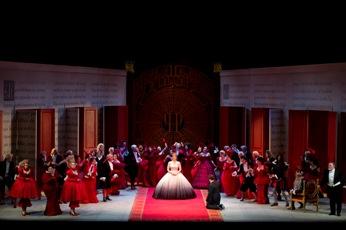Jules Massenet – Cendrillon (2011)
Jules Massenet – Cendrillon (2011)

01 Introductions 02 Cendrillon - Act 1 03 Set Change 04 Cendrillon - Act 2 05 Interval 06 Cendrillon - Act 3 07 Set Change 08 Cendrillon - Act 4 09 Curtain Calls Cendrillon - Joyce DiDonato (Mezzo-soprano) La Fee - Eglise Gutierrez (Soprano) Le Prince Charmant - Alice Coote (Mezzo-soprano) Madame de la Haltičre - Ewa Podles (Mezzo-soprano) Pandolfe - Jean-Philippe Lafont (Baritone) Noemie - Madeleine Pierard (Soprano) Dorothee - Kai Ruutel (Mezzo-soprano) Roi - Jeremy White (Bass) Doyen de la Faculte - Harry Nicoll (Tenor) Surintendant des Plaisirs - Dawid Kimberg (Baritone) Premier Ministre - John-Owen Miley-Read The Royal Opera Chorus The Orchestra of the Royal Opera House Bertrand de Billy – conductor ROYAL OPERA HOUSE, COVENT GARDEN, LONDON 9 July 2011
The solid-looking walls in this production carry the text of Perrault’s fairy tale Cinderella, as if to reassure us that our lovely heroine will indeed eventually get her prince. For there is delicious uncertainty in Act III of this Massenet opera when Cinderella’s nasty step-mother and sisters assure her that after the bold intruder made her rapid exit from the ball, the prince decisively rejected her. This is too much for her father, who notices her grief and finally finds the backbone to defy his wife. In a tender duet with his daughter he promises they will return to his country seat and leave this town where he’s seen her cheerfulness fade away. Rather than allow her father to share her pain, however, she decides to run away and die alone. Her plaintive soliloquy Adieu, mes souvenirs de joie was most beautifully sung by Joyce DiDonato, ending with quietly sweet regret. The woodland scene that follows was played among roofs and chimney pots, and it worked well as the fairy godmother conjures up a gradual recognition between Cinderella and her prince, most gloriously and strongly sung by Alice Coote. Their duet was fabulous.
Why do we not see this opera more often? Preliminary plans were made in 1896 at the Cavendish hotel on Jermyn Street when Massenet and his librettist Henri Cain were in London for the premiere of La Navarraise. Upon its completion three years later a lavish first production was given in Paris at the Opéra Comique and was a great success, yet its first UK production was not until 1928, and this is amazingly its first performance at Covent Garden. In this version of the Cinderella story by Massenet and Cain, the two young principal characters are portrayed as desperate, lost children, hence the musical reason for not casting a tenor as the prince, yet the most widely available recording at one time did precisely this, and as Rodney Milnes writes in the Grove Dictionary of Opera, “there is neither authority nor tradition for this reprehensible practice”.
Could this be partly a reason for the neglect of this opera? To be sure, Massenet was viewed unkindly at one time as a composer of drawing room romances, reflecting the personal and intimate nature of many of his works, but failing to credit their well-organised dramatic element, and the composer’s uncanny ability to fit music to words in a way that seems utterly natural. Cinderella’s Vous êtes mon Prince Charmant is a delightful example. And then there is the wonderful orchestration, such as the off-stage use of a lute, viola d’amore and ‘glass flute’ for the entrance of Prince Charming in Act II. The orchestration of this scene even reminded me of the meeting between Octavian and Sophie in Strauss’s Rosenkavalier. Ballet lovers will also recognise some of the music from Kenneth MacMillan’s ballet Manon, which was arranged by Leighton Lucas to music entirely from Massenet’s works.
But this is an opera that needs to be seen rather than just heard, and Laurent Pelly’s production, first staged at the Santa Fe Opera in 2006, is superb. I love the set designs by Barbara de Limburg, the choreography by Laura Scozzi, and the unnatural fairy tale element expressed by those extraordinary red costumes designed by Pelly himself, along with the red make-up on the footmen, and the absurd derrière of Madame de la Haltière, the stepmother. She was gloriously performed by Ewa Podles who used her vast range of pitch to the full, giving us low notes that seemed to run along the floor of the stage.
The nasty sisters were vivaciously played by Madeleine Pierard and Kai Rüütel, both in the young artists programme, and Eglise Gutiérrez exhibited wonderful top notes as the fairy godmother. Jean-Philippe Lafont was a quietly engaging and immensely sympathetic father who gained vocal strength as the evening progressed, and I loved his gravelly tone. Altogether this was staged to perfection with a wonderful cast, and the fact that it is a co-production with Barcelona and the Theatre de la Monnaie in Brussels speaks for its international attraction. Well-known operas occasionally attract very odd and self-indulgent productions, but this relatively unknown work has been given the magical production it needs to engage us. Do not miss it, because although it will surely be revived, this is a terrific cast, with very fine musical direction from Bertrand de Billy. ---Mark Ronan
download: uploaded anonfiles mega 4shared mixturecloud yandex
